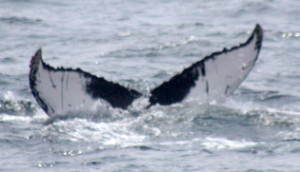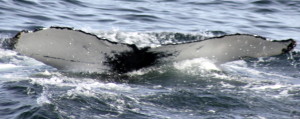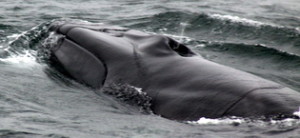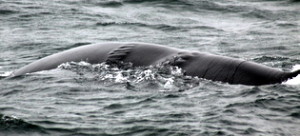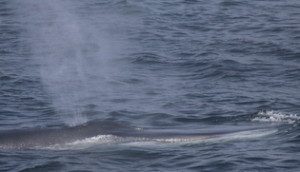Dolphin Fleet Naturalist Notebook – 14 May to 20 May
Nasty weather continued into the weekend. Although the seas had died down by May 14, a heavy blanket of fog had settled over Provincetown and the surrounding waters and it refused to lift. Because we find whales using our eyes and binoculars, rather than with tracking equipment, fog can make our day very challenging. The morning trip aboard the Dolphin IX was unable to find any whales, so each of our passengers received a 1% club ticket — a free ticket for another trip, reflecting the fact that it is only on 1% of our trips that we fail to find whales.
On the mid-day trip aboard the Dolphin VIII got lucky and found a juvenile humpback slowly traveling in the fog. It spent a lot of time just beneath the surface giving us nice looks at long, slow tail strokes.
On the second trip aboard the Dolphin IX, we got a report of a humpback in a particular area. Went to the spot but the wind picked up and blew more fog in so we never found it. Headed west in the fog and we were thrilled to come upon a big finner. It appeared to be literally riding the surf and lifted it’s tail enough for us to see the dorsal surface of its fluke! Behaving unlike our typical fast and elusive fin whales, it stayed up was moving slowly and we got great looks.
As we were heading in by Herring Cove we spotted a smaller fin whale. We were in 28 feet of water and we watched it work the edge where it dropped off to 168 ft. It was running along the wall, probably exploiting fish that sometimes congregate along these edges. This whale we could actually watch on the boat’s depth sounder, although it wasn’t spending too much time at the surface.
It was also a great day for bird sightings. The Audubon Society‘s bird-a-thon took place this weekend with 21 species of seabirds sighted by birders aboard the Dolphin IX. Among them were: red-throated and common loons, northern gannet, Wilson’s storm petrels, common eiders, white-winged and black-winged scoters, red-breasted mergansers, parasitic and pomerine jaegers, black-backed, herring, ring-billed, laughing, Iceland, and Bonaparte’s gulls, roseate, common, and least terns.
Razorbills were both sighted in the fog aboard the Dolphin VIII. Razorbills are a particularly interesting sighting. They are related to auks, and have a similar diet to many of the other large whales and seabirds in the area. Spring can be a good time to catch a glimpse of these birds as they from warmer waters to the rocky islands where they lay their eggs.
May 15th looked a bit more promising, with calm waters in the bay. However, we ran into a big fog bank offshore and had to start relying rather than our ears, rather than our eyes, to locate the blows of whales. Luckily, within 20 minutes, a pair of humpbacks appeared along with a small pod of Atlantic white-sided dolphins. The humpbacks swam alongside us, one rolling, repeatedly displaying beautiful belly markings and rorqual pleats.
We were able to identify the two humpbacks as individuals named Fray and Komodo, based on the many unique markings on their tails. Komodo is the 2007 calf of Rune, a female who frequently spends much of the summer in our region.
Komodo
Fray
Later in the afternoon, we traveled back to Stellwagen Bank where we located Mogul, another humpback who has been seen in the area over the past week. Mogul is a male first seen in 1986.
After traveling south, bracing ourselves against the swell coming from the southeast, we saw Hancock, another familiar humpback. Great looks, despite the chilly, wet weather!
In other regional whale news, an aerial survey conducted by the Provincetown Center for Coastal Studies on Friday documented no right whales in Cape Cod Bay. After a record-breaking season, it seems that these whales have moved on to other feeding grounds, as they often do in early May. As a result, the speed limit was lifted in Cape Cod Bay, meaning our boats can travel a little bit faster–and by extension, farther, to find whales.
A big swell off of Herring Cove on May 17th prevented us from getting too far offshore, but it did allow us to spend some quality time with the often under appreciated fin whale. In the morning, we were able to identify the fin whale as an individual named Shark. Shark was first photographed in 1981. Note the entanglement scars near the jaw line. Although fin whales are rarely reported as entangled on this coast, there is some evidence that entanglements do represent a risk to this population.
In recent years, naturalists have been trying to put in more effort towards recognizing individual fin whales. Fin whales pose more of a challenge to this effort because of their elusive behaviors and more subtle markings. Although they can be identified by the blaze and chevron patterns on their right side, these markings can be difficult to see. It is often easier to identify them by the size, shape, and marks on their dorsal fin. We can identify Shark by the notch at the base of the dorsal fin.
In the afternoon, we identified another individual, Braid, whose propeller scars make an identification much more obvious. Braid was first 1980, and has been identified in 16 years since then. The double set of propeller scars is most apparent on the left side. Braid is also a male.
The dense fog on the morning of May 19th made it difficult to find anything in the morning, save for a group of harbor seals hauled out on Long Point. Our passengers received free tickets to come back and try again another time. Later in the day, rather than heading up to Stellwagen into the very dense fog, we decided to explore the bay and had a bit more luck finding some fin whales. We encountered an old favorite — Loon, one of the most frequently-seen fin whales in these parts. Loon has an unusual scar which resembles a Loon on its side, as well as a very distinct dorsal fin.
A second fin whale, who we were unable to identify, was feeding in the same general area. Although fin whales are known for their great bursts of speed, these whales were moving relatively slowly, allowing for spectacular looks at their throat pleats ballooning out as they engulfed massive quantities of fish.
The stubborn blanket of fog continued to cling to the tip of Cape Cod through May 20th. Today we saw 1 Harbor seal, 2-3 Harbor porpoise, and 2 fin whales. With only 1 mile of visibility, we stayed in the bay as we heard that other boats were having no luck finding whales offshore. We found 1 fin whale near the steep drop-off near Race Point and had great looks. It appeared to be feeding just beneath the surface. It lunged out of the water once, almost snapping its jaw. This is something that we see in humpback whales, but rarely in fin whales. The second fin whale was low key but we were able to get close looks.
Here’s where our boats went this week:







